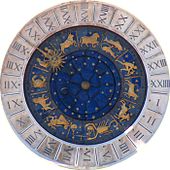Cāmara yoga
| Astrology |
|---|
 |
| Background |
| Traditions |
| Branches |
| Astrological signs |
| Symbols |
Cāmara yoga (Sanskrit: चामर) is an auspicious yoga (planetary combination) which blesses a person with name, fame and riches; and a Rāja yoga which confers upon a person a high social and official status, and ability and opportunity to lead, rule and administer.
The Sanskrit word cāmara means "chowrie" or "yak-tail," which is an insignia of royalty[1]
Summary
The standard texts on Hindu astrology have given three versions of Cāmara yoga.
According to Parashara Cāmara yoga arises if Jupiter aspects the exalted lord of the lagna situated in a kendrasthana or if two benefic planets combine in the lagna, in the 7th, in the 10th or in the 9th bhava. The person will be a king, honoured by kings, long lived, scholarly, eloquent and versed in all arts.[2] This Raja yoga is based on the placement of the lord of the lagna in the auspicious bhavas beneficially influenced by the most benefic planet, Jupiter. In this event the lord of the lagna becomes the Raja yoga-karaka. Janardan Harji begins the Raja yoga section of Mansagari stating – If at the time of birth the lord of lagna vested with strength is a kendrasthana or in a trikonasthana or in the 11th house from the lagna the person will be blessed with the whole paraphernalia befitting a king; the person if lowly born will live like a king.[3] Parashara himself states that if the yoga-kāraka is in an auspicious bhava, sign or navamsa it makes one blessed with plenty of wealth but if such an auspicious planet is in a kendrasthana the person becomes a ruler; if the rasi or navamsa or drekkena rising in the lagna-bhava, ghati-lagna and hora-lagna or any two are aspected by a strong planet a Raja yoga will arise.[4] Even otherwise, the exalted lord of the lagna occupying a kendrasthana will be causing a Panch Mahapurusha yoga. Vaidyanatha Dikshita has given the Parasari description of Cāmara yoga in his Jataka Parijata and states that the person will be either a philosopher, wise, eloquent, and held high in esteem by kings or be a king who being competent by birth to enter on the study of the sacred scriptures has mastered everything connected therewith and live for seventy-one years.[5]
Mantreswara gives a different version of Cāmara yoga. In Sloka 44 of Chapter VI of his Phaladeepika, he states that – if the lagna is either occupied or aspected by a benefic planet, the lord of the lagna is not combust and is in an auspicious bhava in its own sign or own vargas, then Cāmara yoga is caused; the person blessed with this yoga will be good-looking, attractive, intelligent, wealthy, respected and a king who will prosper like the bright-half waxing Moon.[6] This yoga highlights the importance of the strength of the lord of the lagna and the benefic influence it happens to receive.
According to Jatakadesh Marga, which states:-
- पूर्वपक्षे दिवा जन्म लग्नेशे स्वोच्चभं गते |
- धनकेन्द्रगते जीवे योगश्चामरसंज्ञकः||
Cāmara yoga will arise for the person born in the day-time on a shukla-paksha (period of brightening of the Moon) tithi who has the lord of the lagna occupying its exaltation sign and Jupiter is either in the 2nd house or in a kendrasthana from the lagna.[7] The basis of this Raja yoga formation is the strength of the lord of the lagna, the lagna-kendra and the 10th house and with the Moon shining brightly in the night-sky and the Sun occupying the 9th, the 10th or the 11th bhava counted from the lagna. Jupiter situated in a kendrasthana, trikonasthana or the 11th house from the lagna cancels the adverse effects of all weak planets if there be any, and makes one lead a grand life.[8]
References
- ^ "Sanskrit dictionary". Spokensanskrit.de.
- ^ Brihat Parashara Hora Shastra (PDF). Manoj Pocket books. p. 13.
Chapter XXXVI.Slokas11-12
- ^ Janardan Harji. Mansagari. Savitri Thakur Prakashan. p. 242.
Chapter IV Raja yoga Sloka 1
- ^ Brihat Parashara Hora Shastra. Manoj Pocket books. p. 200.
Chapter XXXV. Slokas 46-48
- ^ Vaidyanatha Dikshita. Jataka Parijata Vol.2. Ranjan Publications. p. 457.
Chapter VII. Sloka 136
- ^ Gopesh Kumar Ojha (2001). Phaladeepika Bhavarthabodhini. Motilal Banarsidass. pp. 145, 147. ISBN 9788120821477.
- ^ Ernst Wihelm. Core Yogas. Kala Occult Publishers. p. 173. ISBN 9780970963611.
- ^ Janardan Harji. Mansagari. Savitri Thakur Prakashan. p. 244.
Chapter IV Raja yoga Sloka 10
